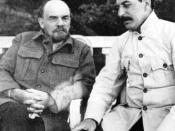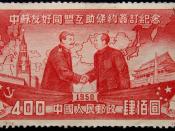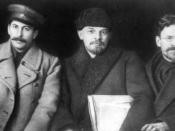Lenin became chairman of Council of People's Commissars and virtually the dictator. The new governments first acts were to make an armistice with Germany and to abolish private ownership of land, and to divide it up between the peasants. Lenin fulfilled his promise of peace by accepting the humiliating treaty of Brest-Litovsk.
In 1919, Lenin established the Third International, or Comintern, to further world revolution. The policy of "war Communism" prevailed until 1921. It brought extensive nationalization, food requisitioning, and control over industry. In 1921, in an attempt to boost the economy, Lenin launched the New Economic Policy, (NEP) which allowed some private enterprise.
By 1922, Lenin had eliminated all organized opposition and had silenced hostile factions within the party. In fact, Lenin had set up a dictatorship of the Communist party, which controlled the hierarchy of local, regional, and central soviets. He retained the post of chairman of the Council of People's Commissars and was a member of the ruling Politburo of the Communist party until his death.
The strain of Lenin's labors destroyed his health. He suffered a stroke in 1922; a later stroke (1923) deprived him of speech. In a testament criticizing Stalin, written near the end of his life, he recommended Stalin's removal from the post of general secretary of the party. After his death (Jan. 21, 1924) this testament was suppressed, and Stalin emerged victorious in the contest for succession.
The October Revolution of 1917, Stalin, already a member of the central committee since 1912, entered the Soviet cabinet as people's commissar for nationalities and began to emerge as a leader of the new regime. During the civil war from 1918 to 1920 he played an important administrative role on the military fronts and in the capital. He was elected (1922) general...



Gr8 help.
Thanx 4 the essay, gr8 help 4 my history project! best info I have seen on this subject anywhere! nice one.
Thanx again.
0 out of 0 people found this comment useful.